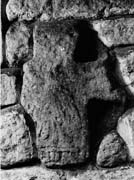Select a site alphabetically from the choices shown in the box below. Alternatively, browse sculptural examples using the Forward/Back buttons.
Chapters for this volume, along with copies of original in-text images, are available here.
Object type: Part of cross-head [1]
Measurements: H. 39.5 cm (15.5 in); W. 27 cm (10.6 in); D. Built in
Stone type: Medium-grained, brownish-yellow (10YR 6/6) sandstone; see no. 1.
Plate numbers in printed volume: 437
Corpus volume reference: Vol 3 p. 129
(There may be more views or larger images available for this item. Click on the thumbnail image to view.)
Only one face is visible.
The central part of a cross-head with ring, type 2(b), in which the recessed ring links the arm-ends. The arms are probably of type E6, with angular arm-pits. The ring is formed by irregular holes gouged in the arm-pits. There is a flat perimeter moulding.
A (broad): The face of the cross is occupied by a Crucifix. Christ is clothed in a long robe with rough pleats following the fan of the skirt. The heels are together and the feet splayed. The head and arms are almost worn away, but the top of the head was flattish. The halo noted by Coatsworth is difficult to determine owing to the worn condition of the carving (Coatsworth 1979, I, 239–40). Below the kirtle is a thin horizontal band indicating a hem.
B–D: Built in.
The ringed cross-head is common in Anglo-Scandinavian sculpture in Ryedale, though the placing of the ring at the arm ends is unusual.
The Crucifixion is placed in the Irish manner on the cross-head and the robed, standing figure is in line with the Insular tradition. The Kirkdale and Sinnington Crucifixions demonstrate the hold that tradition enjoyed in Ryedale. This piece belongs to a Norse-Irish milieu, the context which produced so much sculpture to the north in Allertonshire (North Riding), where similar placings of the Crucifixion occur. The rough pleats of the robe speak of amateurish carving. The elaborate skirt is unusual in Ryedale but may be compared with Irish manuscript and metalwork depictions: for example, the Athlone book mount (Henry 1965, pl. 46), and the simplified versions in Cumbria on the Gosforth cross and the Penrith plaque (Bailey and Cramp 1988, ills. 304, 525), which may be derived from Irish models.



